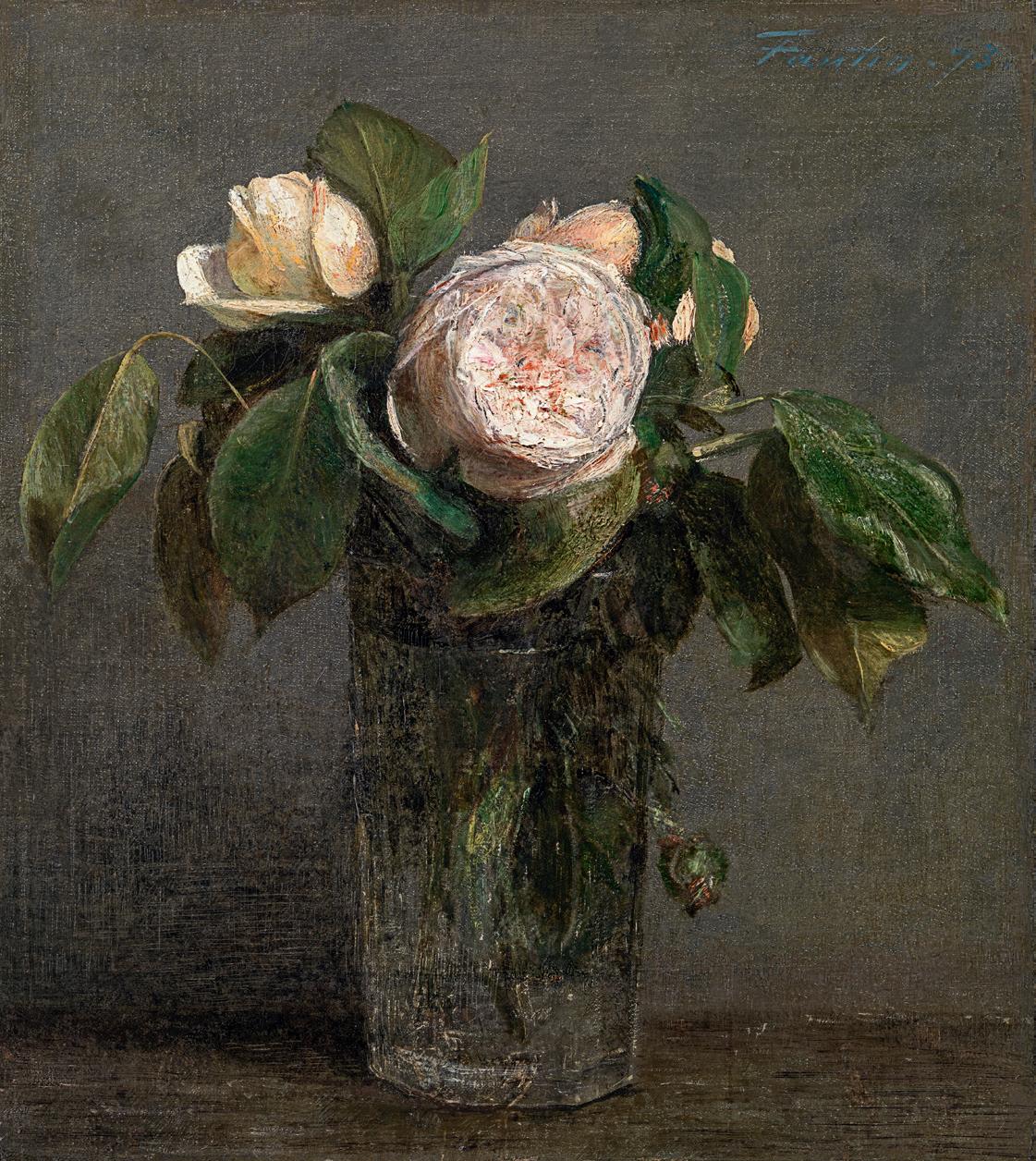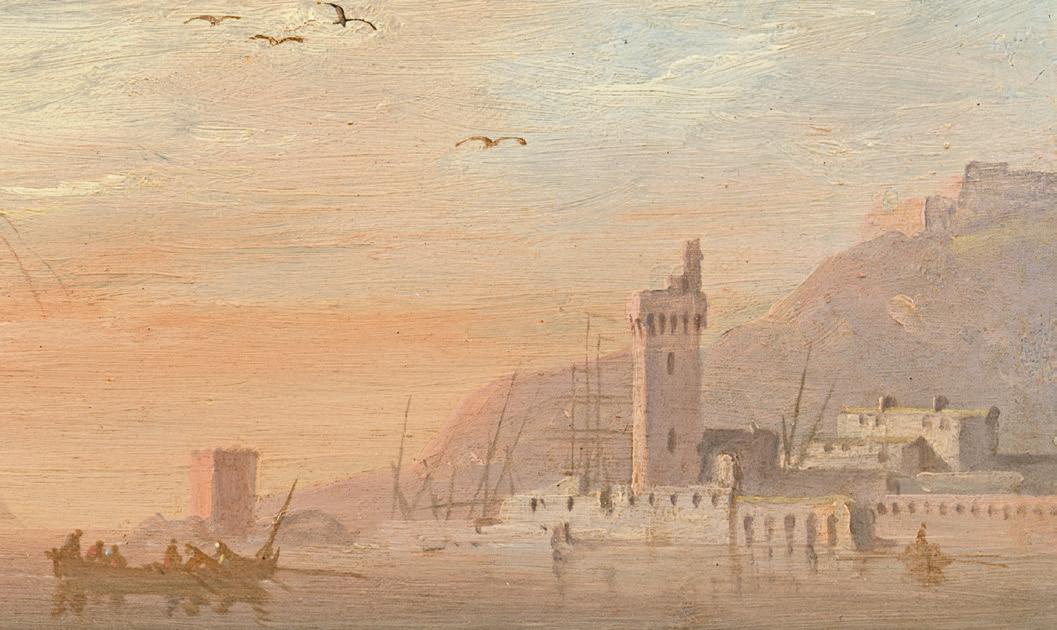
9 minute read
CHARLES-FRANÇOIS
GRENIER DE LACROIX called LACROIX DE MARSEILLE
Sunrise: Levantine merchants on a quay below a castle, a Dutch man-of-war at anchor beyond
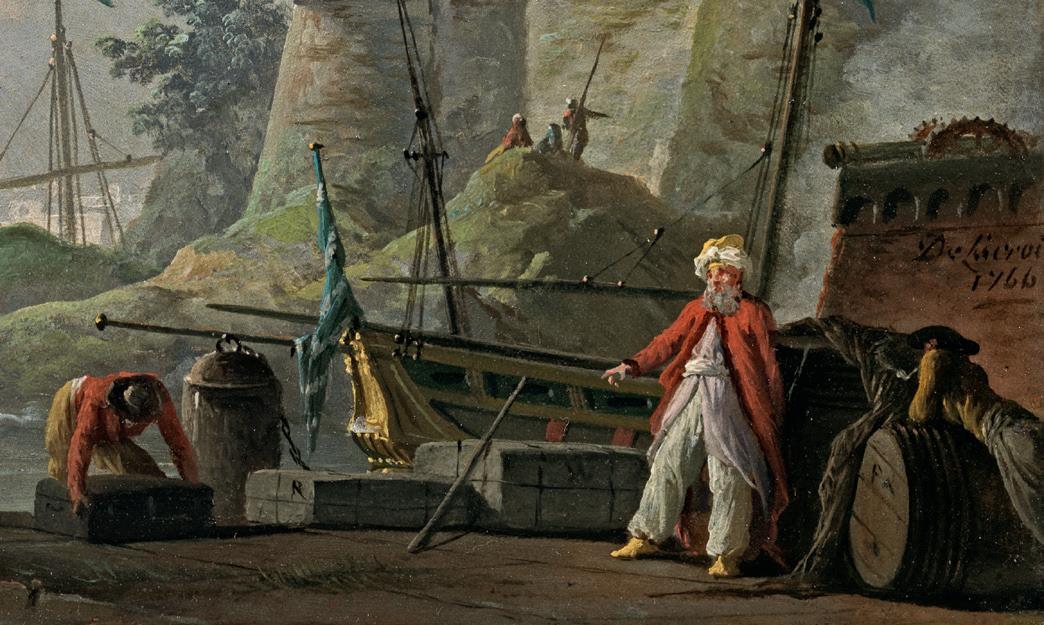
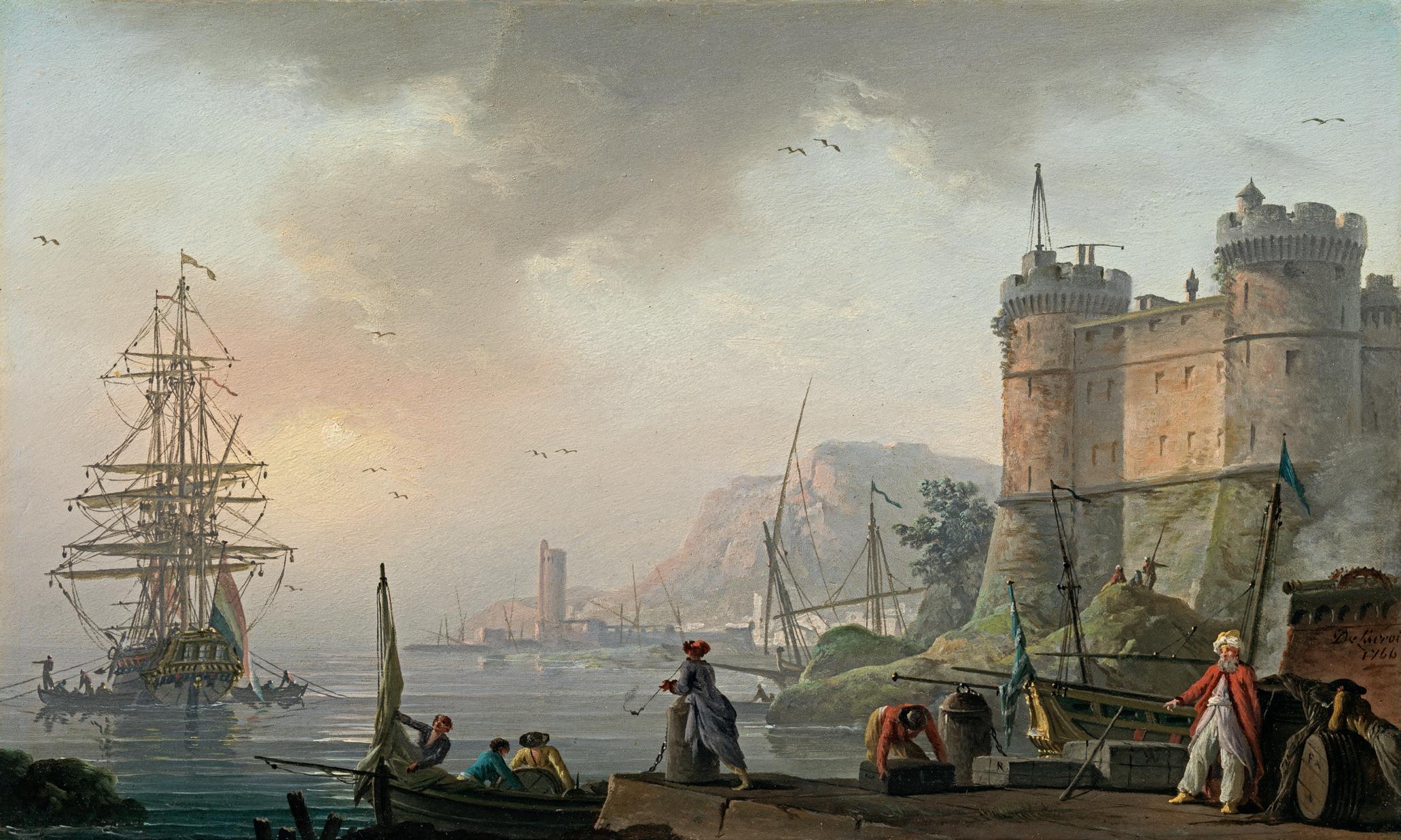
Sunset: fishermen preparing their nets, a port and a Dutch man-of-war beyond
Lacroix de Marseille was strongly influenced by the paintings of Claude-Joseph Vernet (1714-1789), whom he encountered in Rome in the 1750s. Like Vernet, he often executed landscapes in pairs which evoke the atmosphere of different times of day, typically sunrises and sunsets. This pair of paintings on copper is a fine example of his accomplished and decorative work with its clear, delicate colouring. The copper support provides a smooth surface which enhances Lacroix’s exquisite brushwork, seen in the modulations of the clouds and in the picturesque, elegant figures. Lacroix may have been born in the brutal, bustling port of Marseilles, but his views are of an idealized Mediterranean, perfect souvenirs for Grand Tourists remembering its glorious light in chillier, greyer northern Europe.
In Sunrise, a Dutch man-of-war lies at anchor as she takes on stores in the flat calm. In the foreground, a boat prepares to ferry barrels and chests across, idly watched by two Levantine merchants. These turbanned figures are also a staple of Vernet’s port scenes: they serve as a reminder of the rich cultural mix of the Mediterranean trade routes. Towering behind them is a massive fortress reminiscent of Castel Nuovo in Naples, while the castle in Sunset is not unlike the Castel Sant’Elmo which guards the Bay of Naples. Lacroix visited Naples, then the second-largest city in Europe and an essential stop on the Grand Tour, in 1757.
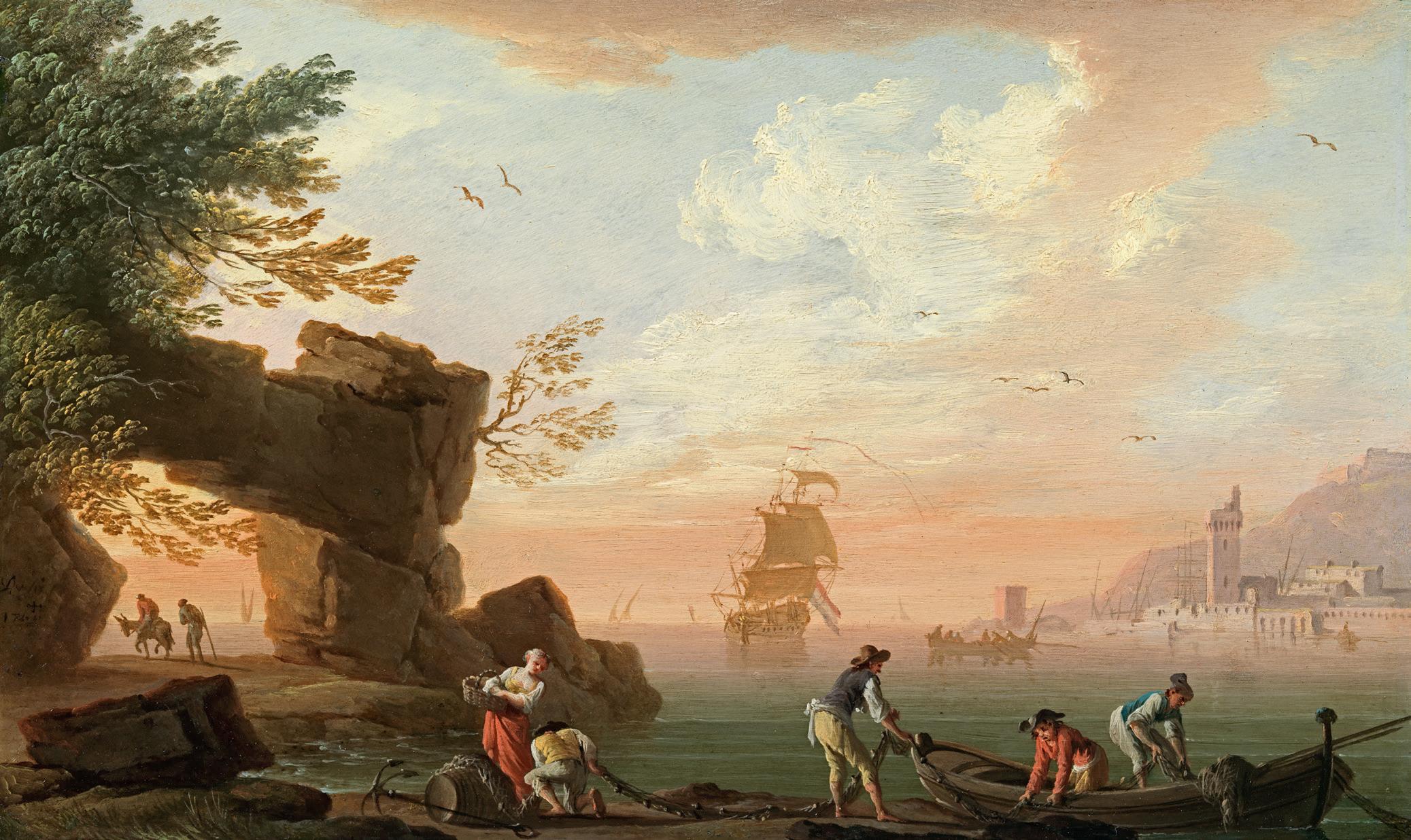
Thomas Gainsborough
Open landscape with a peasant, a milkmaid, four cows and a cottage
Oil on canvas: 22 x 43 ¼ in / 55.9 x 109.9 cm
Painted circa 1772-4
Gainsborough made this painting when, after stellar years as a society portrait painter in Bath, he was about to leave for the grander arena of London. Portraits brought him fame and fortune, but he always declared that landscape was closest to his heart. ‘I’m sick of Portraits and wish very much to take my viols-da-gamba and walk off to some sweet village, where I can paint landskips and enjoy the fag-end of life in quietness and ease’, he complained to a friend.
Landscapes such as this one reminded Gainsborough of his boyhood in Sudbury, Suffolk, roaming the gently-undulating terrain with its fields of ripe wheat and peaceable cattle. A pale gold shimmer lights up the huge sky and casts a radiance around the contours of the cows as they wait patiently to be milked. Gainsborough casts an idealized, Rococo glow over this scene of humble rural life. He often employed milking scenes in his landscapes: the graceful milkmaid echoes the rustic beauties found in novels and plays of the era. Earlier in his career, Gainsborough had painted a milkmaid being wooed by a woodcutter for an overmantel in a room at Woburn Abbey. The elongated shape of the present work suggests that it may have been intended for a similar architectural purpose.
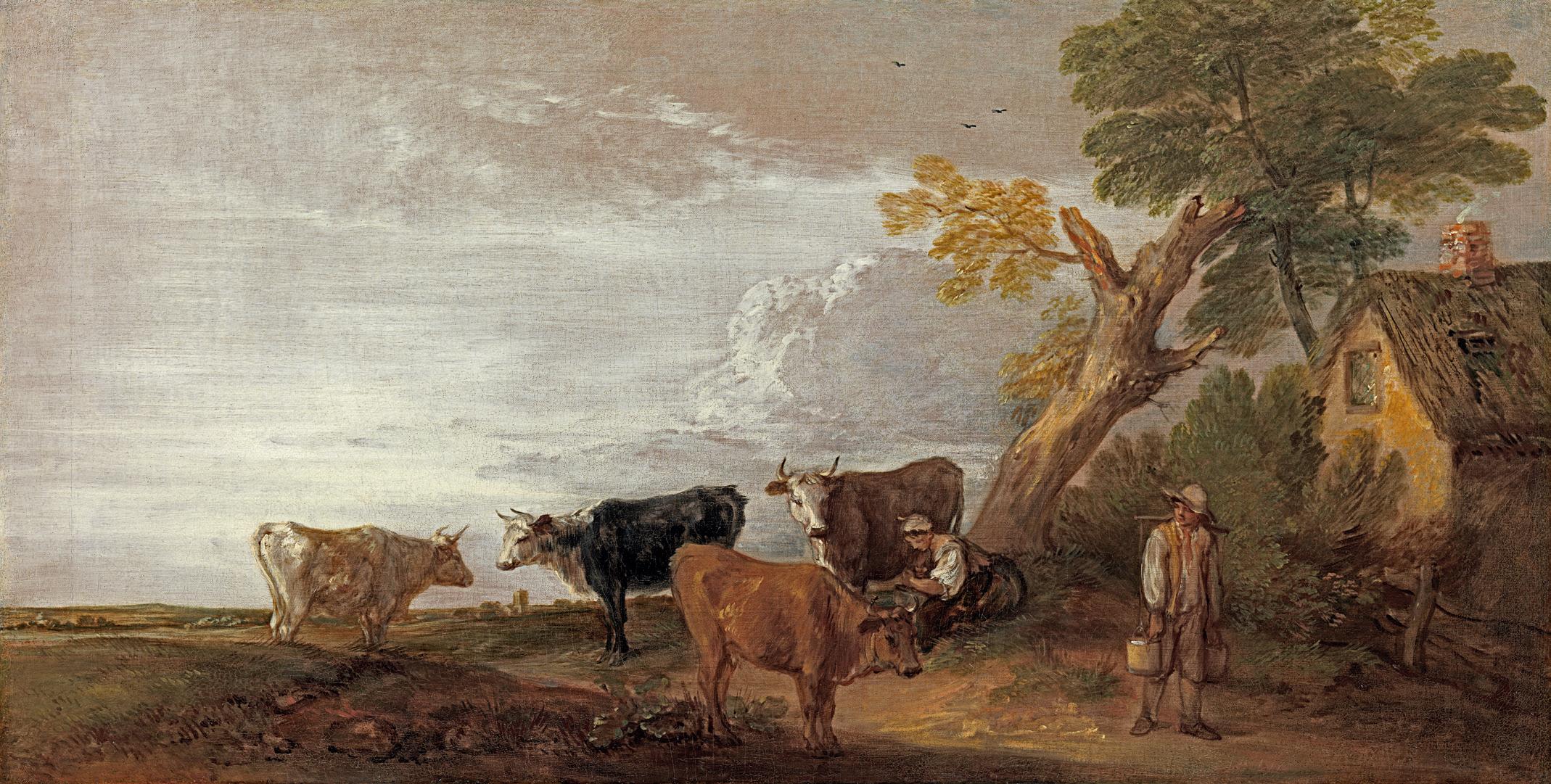
CLAUDE-JOSEPH VERNET
A Mediterranean port at sunset with fishermen landing their catch and a British man-of-war at anchor
Signed and dated lower right: J. Vernet . / f. 1780 Oil on copper: 16 x 19 ¼ in / 41 x 48.9 cm
Claude-Joseph Vernet was born in Avignon in the South of France and spent almost twenty years in Italy, from 1734 to 1753, before returning to his homeland. His idealized views, which found favour with Louis XV and an international clientele, are informed by his intense observation of Mediterranean architecture, nature and light. This work is the more exquisite for being painted on copper, the smooth surface of which is ideal for Vernet’s delicately nuanced cloudscapes and beautifully-observed figure groups. Vernet discovered copper supports – favoured by Dutch painters and introduced from Holland – around 1757, but used copper panels particularly in the later part of his career. This work from 1780 is a superb example of his smaller-scale cabinet paintings. It was probably commissioned by the Abbé Aleaume, Secretary to the Comte de Provence, Louis XV’s grandson (the future Louis XVIII). In 1773 Aleaume wrote a poem entitled ‘Les Quatre Parties du Jour’, an interest in the qualities of different times of day that is reflected in Vernet’s work.
The painting shows Vernet’s ability to harmonize a panoramic landscape with lively human drama. Local fisherfolk contrast with three exotic, Oriental figures standing to the left, observing a British man-of-war and a lateen-rigged Mediterranean craft. Vernet, who painted a great series of The ports of France for Louis XV (1755-65), was a meticulous observer of shipping and often uses men-of-war as important elements in his compositions. (His wife was the daughter of an Irish Captain in the Papal Navy).
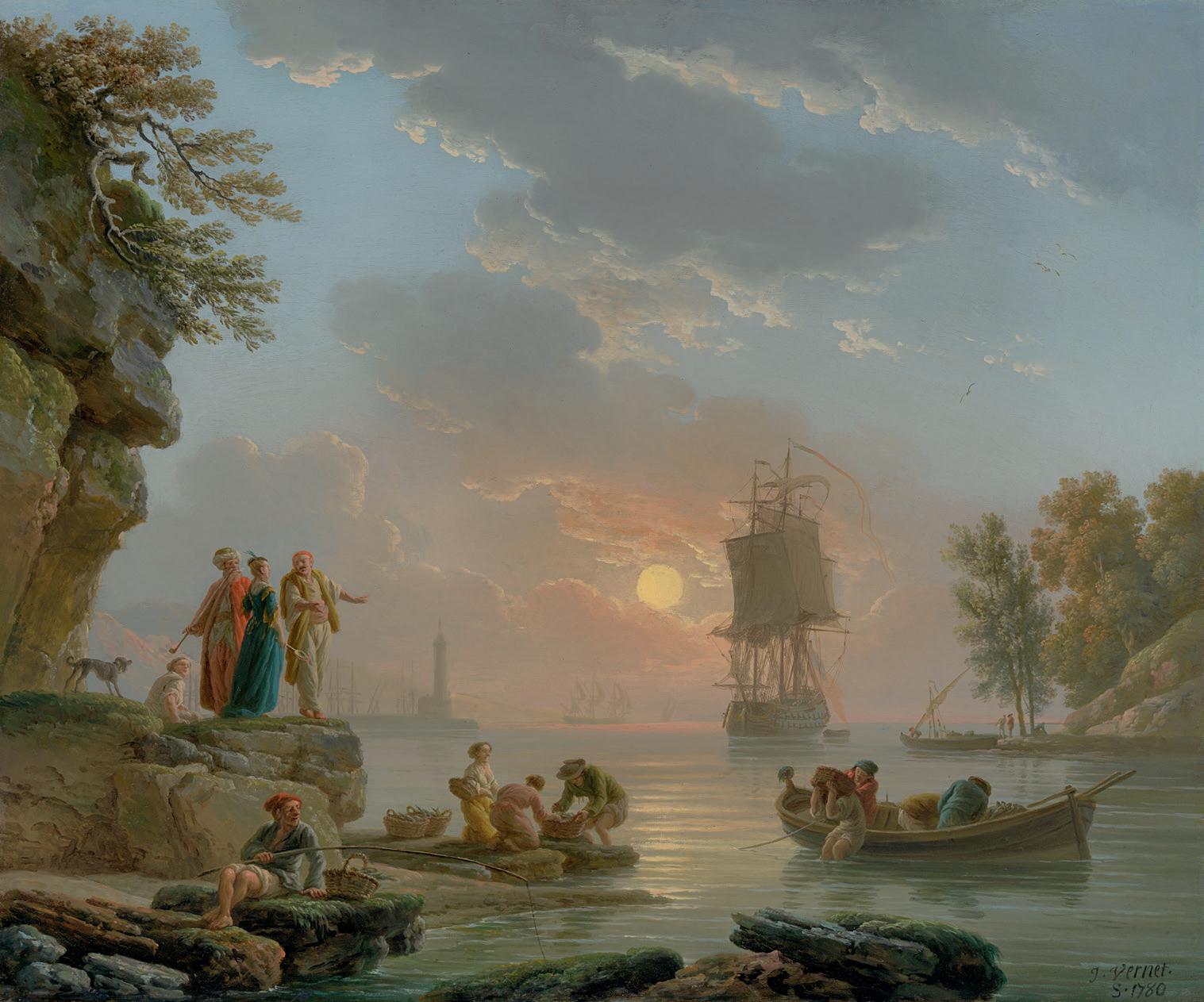
JEAN-BAPTISTE GREUZE
Jeune fille au ruban bleu dans les cheveux
Oil on canvas: 16 x 13 ¾ in / 41 x 35 cm Painted in the 1780s
Jean-Baptiste Greuze sprang to fame with sentimental, moralizing paintings such as L’Accordée de village (Musée du Louvre, Paris), which caused a sensation at the Salon of 1761. In his later career he was admired for his ability to capture expression in his single ‘heads’, often of young women with wistful, ambiguous expressions: the viewer is invited to guess the thoughts beyond the languorous eyes. Joseph Taillasson commented in his 1805 obituary of Greuze: ‘What won him the highest place in the opinion of artists and refined connoisseurs, were the beautiful heads spread throughout all the cabinets of Europe and which are there admired as masterpieces’.
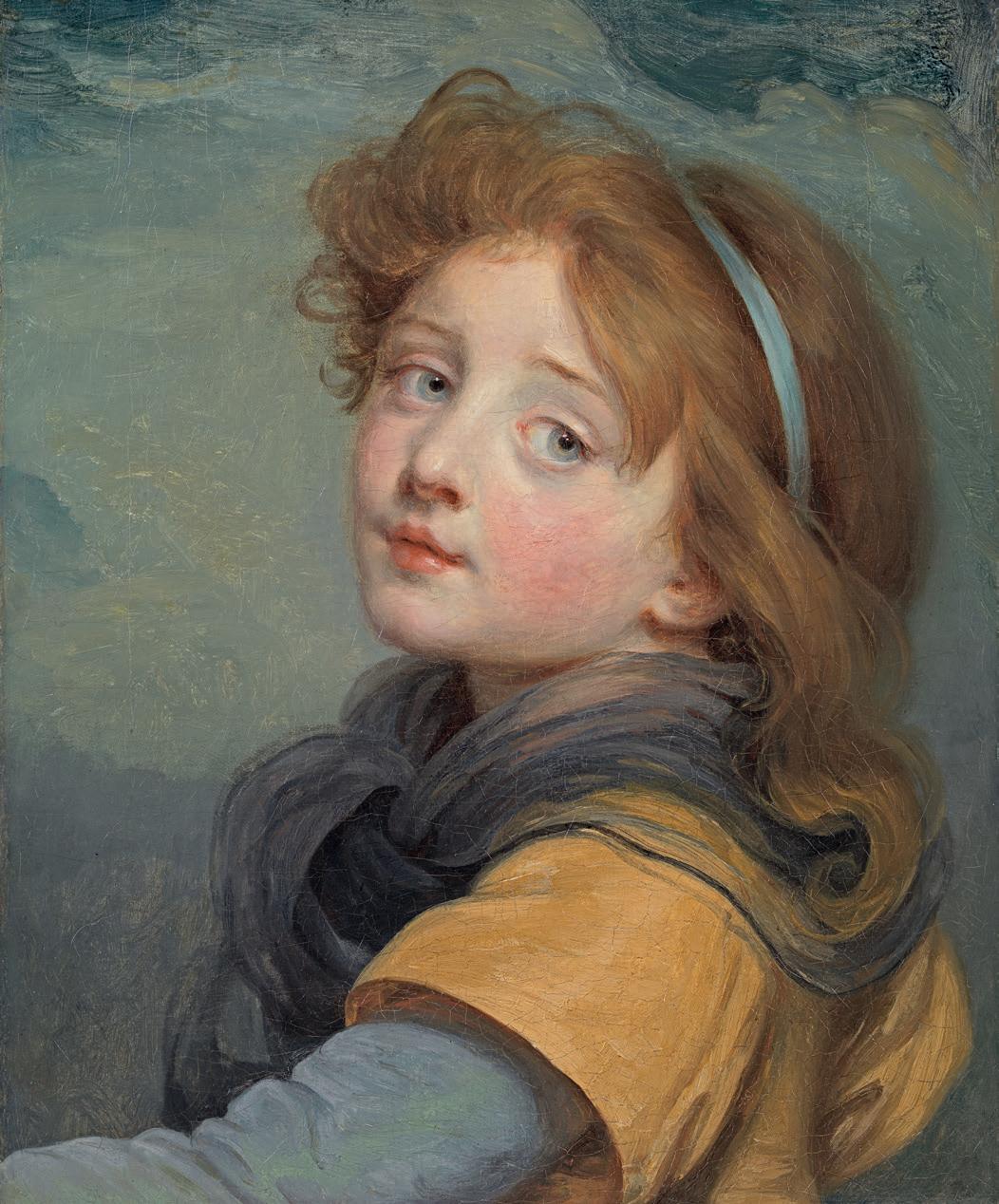
Jeune fille au ruban bleu is remarkable for its directness and vitality. Here is no simpering maiden, but a cheerful Parisian child, full of the exuberance which must have eddied round the Greuze household when his three beloved daughters were young. The girl’s creamy skin and rosy cheeks are painted with the fluidity and softness which Greuze had refined by this period. Her lovely chestnut hair waves in baroque curves, echoed by the exquisitely painted, translucent black scarf at her throat. Luminous grey eyes cast a tender glance. Greuze eschews his characteristic subdued or pearlescent tones in favour of stronger colours. The yellow dress points up the brightness of the child’s hair and contrasts with the black scarf and blue sleeve. An ebullient blue background gives a sense of breezy outdoors. This painting is both a subtle, complex portrait of a particular child and a celebration of youth itself.
Alfred De Dreux
Amazone à la robe rouge dans un paysage
Signed lower left: alfred de dreux
Oil on canvas: 18 x 14 in / 46 x 37.1 cm Painted circa 1845-48
A beautiful woman rides to hounds as the field tears into a dense forest. Fashionably dressed in a red habit, she effortlessly commands her spirited mount, whose arched neck and dish face betray his Arab bloodline. De Dreux matched his portraits of equestrian dandies with their counterpart, the amazone, the haughty, daring and accomplished female rider. To ride well was an important accomplishment for a lady in the age of Emperor Napoleon III. Hunting, a privilege of the aristocracy before the French Revolution, was democratized in the following years. It was avidly pursued by the wealthy bourgeoisie, the bankers and industrialists making fortunes in a rapidly commercializing France, sensible of the social cachet afforded to any human perched atop a fine mount.
De Dreux, the son of an architect, moved in the heady heights of French society, painting the horses of the duc d’Orléans and undertaking commissions for Napoleon III. Passionate about horses from an early age, he studied them on the racetracks at Longchamp and Auteuil. De Dreux evokes the straining muscles and glossy, dark brown coat of the amazone’s steed with a painterly brio that recalls the work of his artistic hero Théodore Géricault (1791-1824), a close friend of his uncle, the painter Dedreux-Dorcey. Alas, all this thoroughbred fire drew de Dreux too close to the sun: he was killed in a duel in 1860 by Comte Fleury, Napoleon’s III principal aide-decamp, after a dispute about an equestrian portrait of the Emperor.
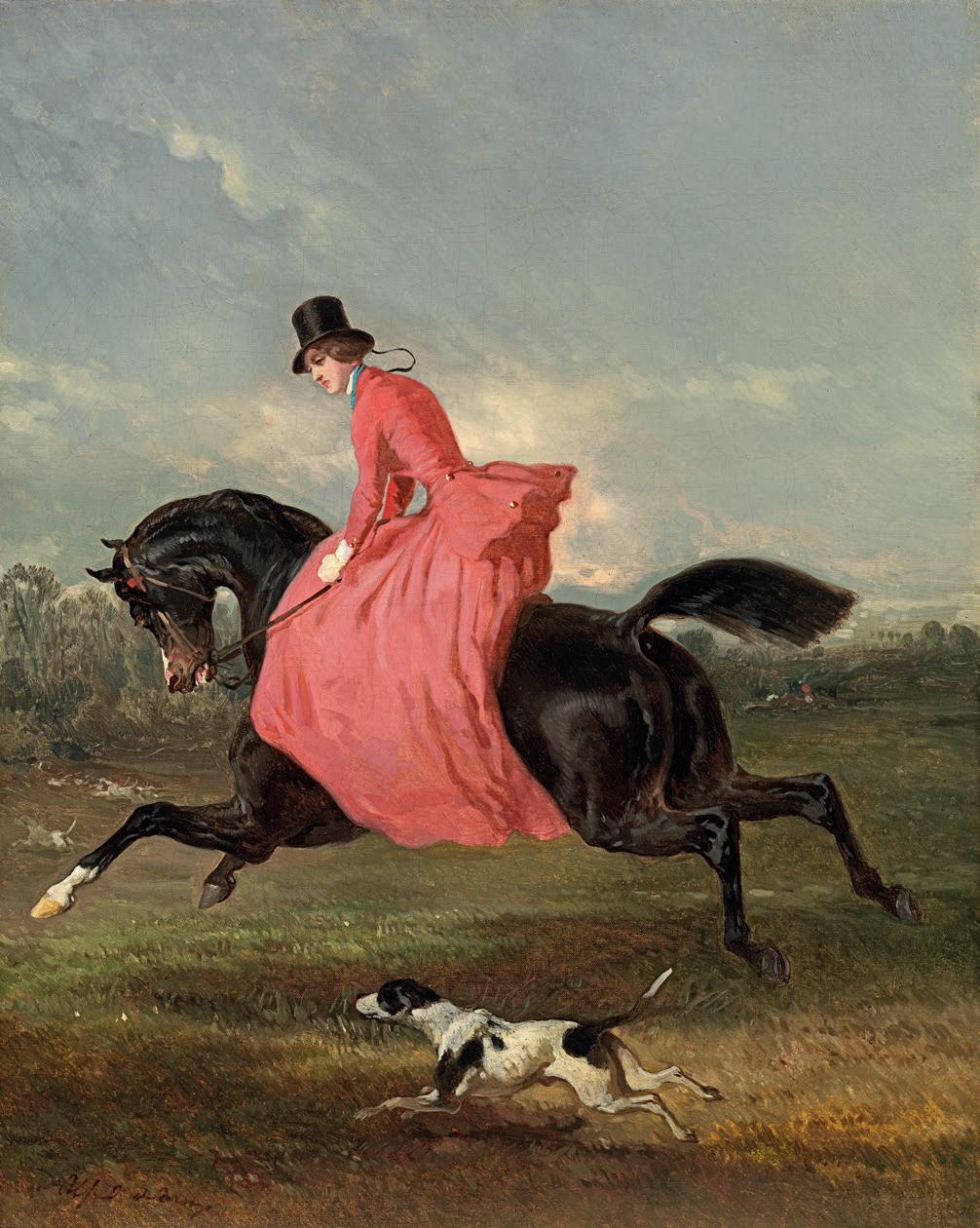
JEAN-BAPTISTE-CAMILLE COROT Le rappel des vaches
Signed lower left: Corot Oil on canvas: 19 ¾ x 29 ¼ in / 50.2 x 74.3 cm Painted circa 1870
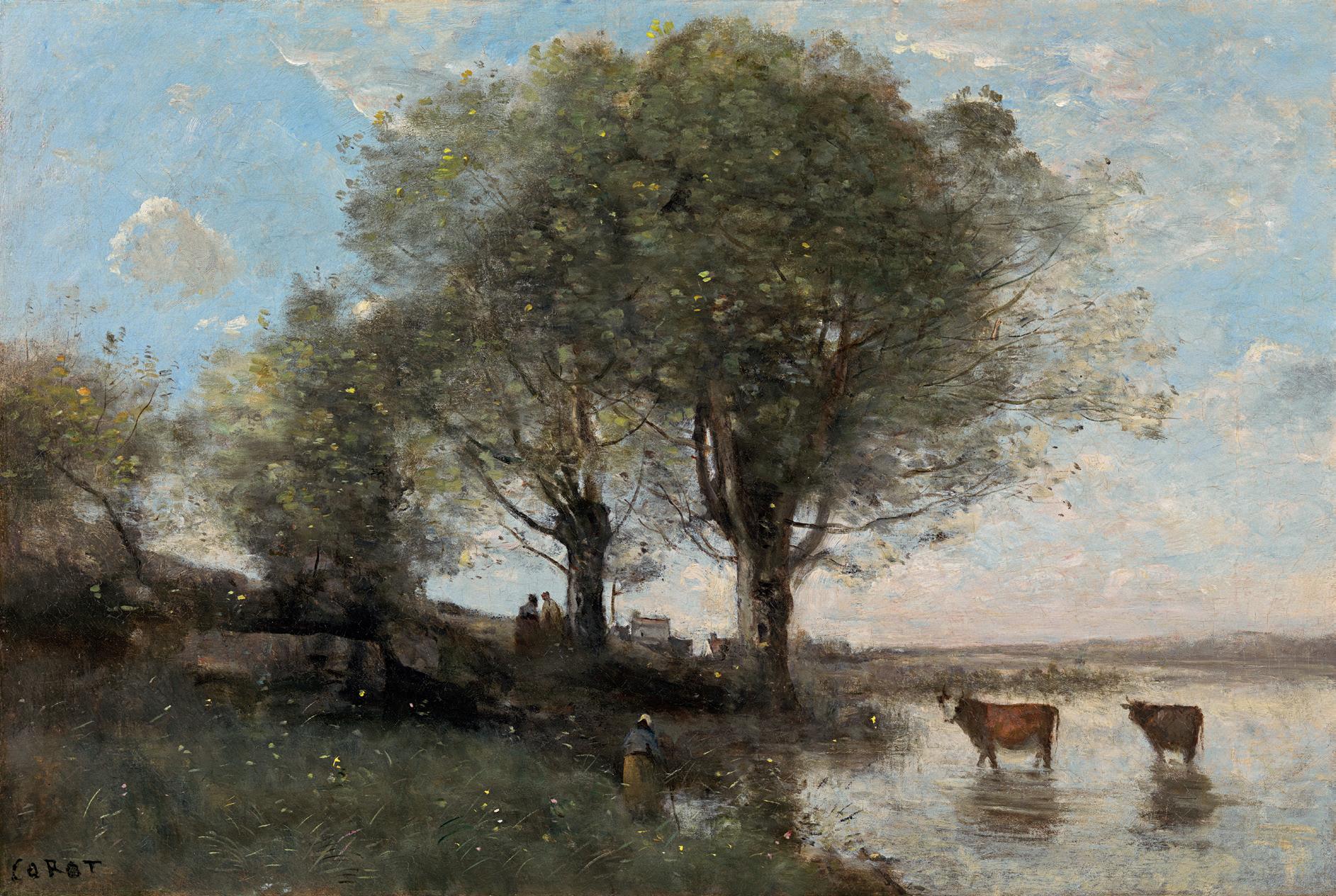
‘Beauty in art consists of a truthfulness in the impression we have received from an aspect of nature...the real is one part of art; the sentiment completes it’, Corot declared in 1856. This painting is a classic example of Corot’s mature work: a silvery evocation of timeless rural life. As the light of a summer afternoon declines gently towards sunset, village women call the cows home for milking. Sunlight filters through the two magnificent trees at the centre of the work, flicks and dabs of gold paint depicting the rustling leaves catching the rays. By balancing areas of sunlight and shadow, Corot creates a dreamy mood of benevolent calm.
Corot observed nature closely before creating idealized landscapes that he called souvenirs, nostalgic distillations of his visual experience.
As a young man in the 1820s he had made his first visit to Italy. He was influenced by the landscapes of the Rome-based Frenchman Claude Lorrain (1600-1682), who found in the countryside of the Roman Campagna a timeless, Arcadian world. Paintings such as Le rappel des vaches are modern explorations of Claude’s Arcadia, echoing the seventeenth century artist’s soft, harmonious palette of gentle blues and greens. As George Bazin comments, ‘Human toil is for Corot to be kept at arm’s length, and the nature that he paints is a kind of Golden Age, where man lives, without too much effort, from the fruits of the field or the milk of his livestock’. Corot’s rich, allusive handling of paint had profound effects on the younger artists – the future Impressionist generation - to whom he gave advice, including Camille Pissarro and Claude Monet.
Eugene Boudin
Camaret, bateaux de pêche
Signed lower left: E. Boudin - 73 Oil on canvas: 27 x 37 ½ in / 68.6 x 95.2 cm
This sparkling scene, made in 1873, perfectly demonstrates why Eugène Boudin was invited to exhibit at the first Impressionist exhibition the following year, showing his work among artists such as Monet, who was nearly two decades his junior. Boudin’s power of observation, sensitivity to light and expressive handling of paint were an inspiration to the ‘young Turks’ who wished to break the mould of nineteenth century landscape art.
Boudin visited Camaret, at the tip of the Crozon peninsula in Brittany, every year between 1869 and 1873. Camaret (called Kameled in the Breton language) was a bustling, strategic port, famed in the nineteenth century for its shipbuilding and its sardine fleet. Lying on the channel that led to the great naval and commercial port of Brest, it was important in the line of French coastal defences (usually against the English). In this painting, Boudin depicts a line of fishing boats on a breezy day, their rust- and cream-coloured sails shimmering in the light. Boudin was particularly exhilarated by the cloudscapes of this coast notorious for its squalls and storms. In his diary of 3rd December 1856, he had mused: ‘To swim in the open sky. To achieve the tenderness of clouds. To suspend these masses in the distance… make the blue explode’. Here, a huge, sculptural cloud spirals over the warships: its brightest part is dazzling, while the louring grey below threatens rain. Boudin’s vibrant brushwork weaves sky, shipping and sea together in a way that conveys his intense response to nature.
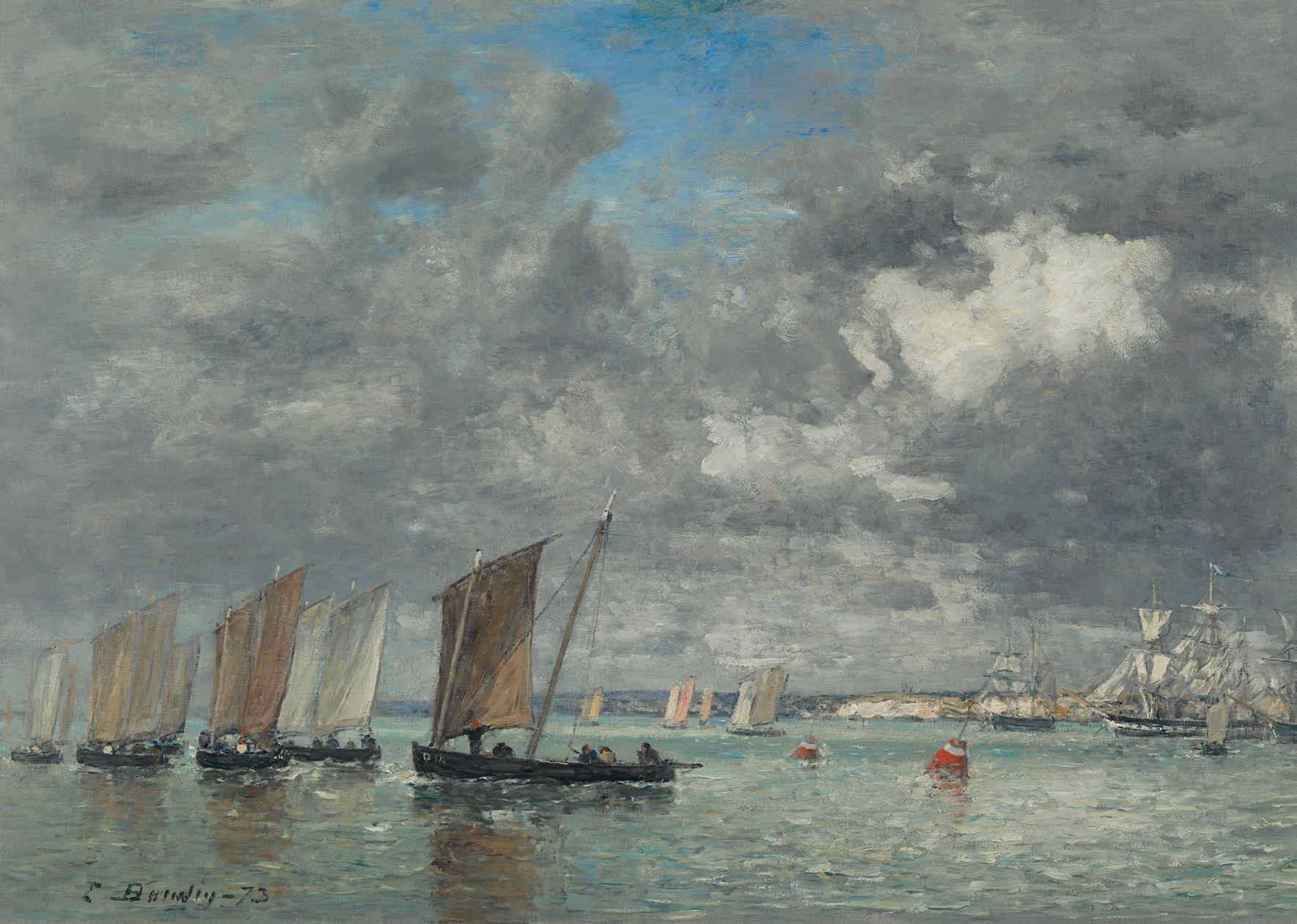
HENRI FANTIN-LATOUR
Roses dans un verre long
Signed and dated upper right: Fantin 73 . Oil on canvas: 10 ¼ x 9 in / 26 x 22.9 cm
Henri Fantin-Latour was a shy man who loved music and hated crowds. Not for him the Impressionist passion for painting en plein air, capturing the fleeting moods of nature. He preferred to study flowers in the calm and silence of the studio. ‘Je n’ai pas l’habitude du monde’, he wrote to his English patron and agent Ruth Edwards, the first owner of this work. Roses are the leitmotifs of his art. As with this painting, he would first prepare a background of soft, textured grey, which would be left to dry overnight. The following day the blooms would be chosen, whether from Mrs Edwards’s garden on visits to England, or from Parisian florists, or, after Fantin’s marriage to the painter Victoria Dubourg in 1876, from the cottage garden of her relatives in Normandy.
Fantin’s roses are portraits of particular flowers, not simple botanical studies. The artist-dandy Jacques-Emile Blanche famously wrote: ‘Fantin studied each flower, its grain, its tissue, as if it were a human face’. The central flower here is a pale pink centifolia rose in pristine glory, with a heart enfolded with strawberry hues and threads of blue shadow. It is flanked by two tight, golden rosebuds and embowered in dark green, glossy leaves. The simple glass container is flecked with points of light. In its perfect simplicity, Roses dans un verre long echoes the contemplative floral still lifes of Jean-Baptiste-Siméon Chardin (1699-1779) and Edouard Manet (1832-1883), both artists whom Fantin greatly revered.
